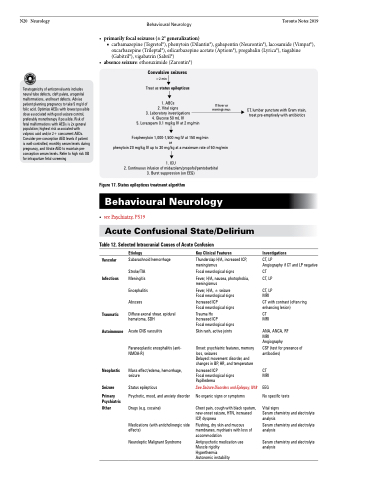Page 762 - TNFlipTest
P. 762
N20 Neurology
Behavioural Neurology Toronto Notes 2019
• primarilyfocalseizures(±2°generalization)
■ carbamazepine (Tegretol®), phenytoin (Dilantin®), gabapentin (Neurontin®), lacosamide (Vimpat®),
oxcarbazepine (Trileptal®), eslicarbazepine acetate (Aptiom®), pregabalin (Lyrica®), tiagabine
Teratogenicity of anticonvulsants includes neural tube defects, cleft palate, urogenital malformations, and heart defects. Advise patient planning pregnancy to take 5 mg/d of folic acid. Optimize AEDs with lowest possible dose associated with good seizure control, preferably monotherapy if possible. Risk of fetal malformations with AEDs is 2x general population; highest risk associated with valproic acid and/or 2+ concurrent AEDs. Consider pre-conception AED levels if patient is well-controlled, monthly serum levels during pregnancy, and titrate AED to maintain pre- conception serum levels. Refer to high risk OB for intrapartum fetal screening
(Gabitril®), vigabatrin (Sabril®)
• absenceseizure:ethosuximide(Zarontin®)
Convulsive seizures
>2 min
Treat as status epilepticus
1. ABCs
2. Vital signs
3. Laboratory investigations
4. Glucose 50 mL IV
5. Lorazepam 0.1 mg/kg IV at 2 mg/min
If fever or meningismus
CT, lumbar puncture with Gram stain, treat pre-emptively with antibiotics
Fosphenytoin 1,000-1,500 mg IV at 150 mg/min
or
phenytoin 20 mg/kg IV up to 30 mg/kg at a maximum rate of 50 mg/min
1. ICU
2. Continuous infusion of midazolam/propofol/pentobarbital 3. Burst suppression (on EEG)
Figure 17. Status epilepticus treatment algorithm
Behavioural Neurology
• seePsychiatry,PS19
Acute Confusional State/Delirium
Table 12. Selected Intracranial Causes of Acute Confusion
Vascular Infectious
Traumatic Autoimmune
Neoplastic
Seizure
Primary Psychiatric
Other
Etiology
Subarachnoid hemorrhage
Stroke/TIA Meningitis
Encephalitis Abscess
Diffuse axonal shear, epidural hematoma, SDH
Acute CNS vasculitis
Paraneoplastic encephalitis (anti- NMDA-R)
Mass effect/edema, hemorrhage, seizure
Status epilepticus
Psychotic, mood, and anxiety disorder
Drugs (e.g. cocaine)
Medications (with anticholinergic side effects)
Neuroleptic Malignant Syndrome
Key Clinical Features
Thunderclap H/A, increased ICP, meningismus
Focal neurological signs
Fever, H/A, nausea, photophobia, meningismus
Fever, H/A, ± seizure Focal neurological signs
Increased ICP
Focal neurological signs
Trauma Hx
Increased ICP
Focal neurological signs
Skin rash, active joints
Onset: psychiatric features, memory loss, seizures
Delayed: movement disorder, and changes in BP, HR, and temperature
Increased ICP
Focal neurological signs Papilledema
See Seizure Disorders and Epilepsy, N18
No organic signs or symptoms
Chest pain, cough with black sputum, new-onset seizure, HTN, increased ICP, dyspnea
Flushing, dry skin and mucous membranes, mydriasis with loss of accommodation
Antipsychotic medication use Muscle rigidity
Hyperthermia
Autonomic instability
Investigations
CT, LP
Angiography if CT and LP negative
CT CT, LP
CT, LP MRI
CT with contrast (often ring enhancing lesion)
CT MRI
ANA, ANCA, RF MRI Angiography
CSF (test for presence of antibodies)
CT MRI
EEG
No specific tests
Vital signs
Serum chemistry and electrolyte analysis
Serum chemistry and electrolyte analysis
Serum chemistry and electrolyte analysis


